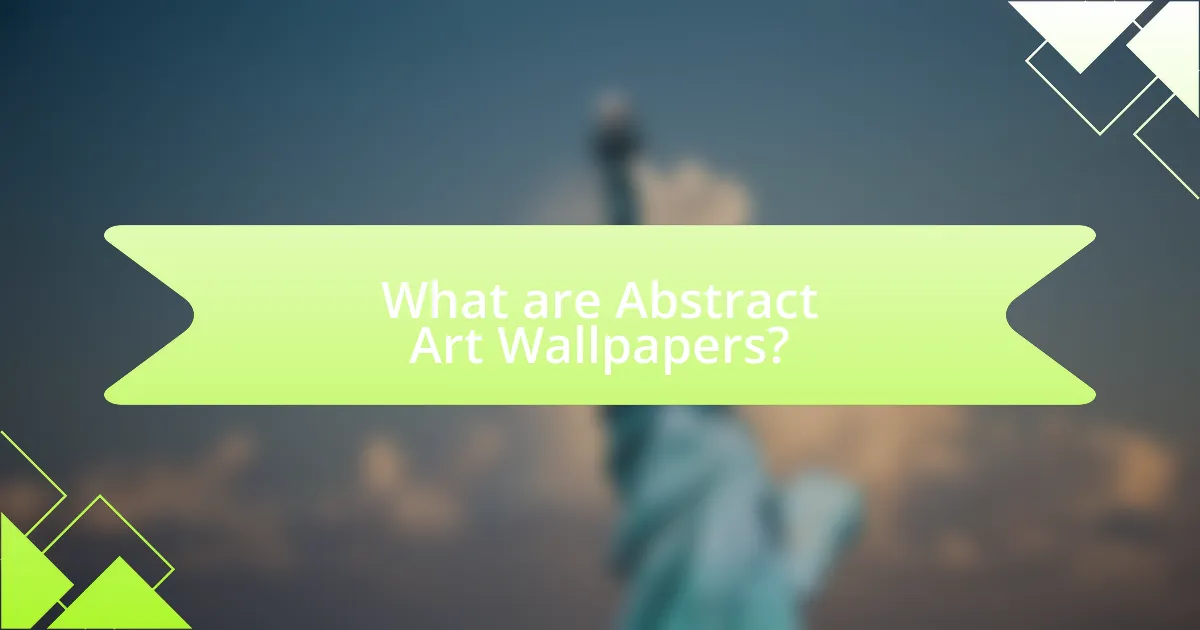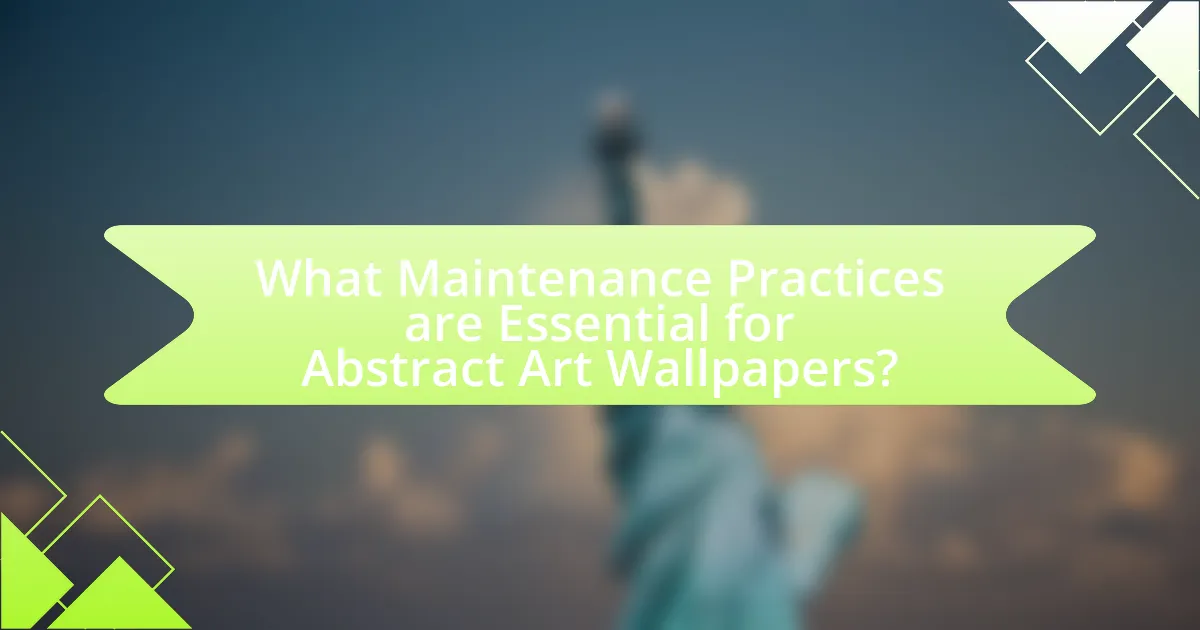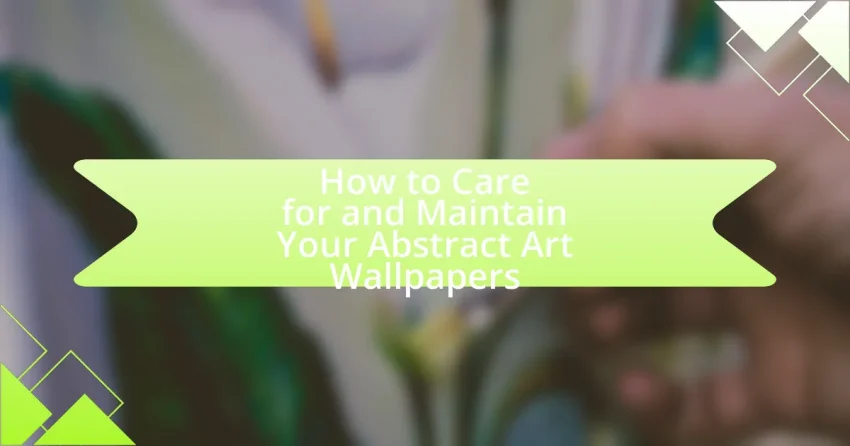Abstract art wallpapers are decorative wall coverings characterized by non-representational designs that emphasize colors, shapes, and forms. This article provides a comprehensive guide on how to care for and maintain abstract art wallpapers, detailing the creation process, materials used, and design techniques. It covers essential maintenance practices, safe cleaning methods, and preventive measures to protect against fading and damage. Additionally, the article addresses common issues such as peeling and bubbling, offering practical solutions for repairs and longevity. Understanding these aspects ensures that abstract art wallpapers remain vibrant and visually appealing in any space.

What are Abstract Art Wallpapers?
Abstract art wallpapers are decorative wall coverings that feature non-representational designs, emphasizing colors, shapes, and forms rather than depicting recognizable objects or scenes. These wallpapers often serve as a focal point in interior design, allowing for creative expression and enhancing the aesthetic appeal of a space. The use of abstract art in wallpapers can transform environments by adding depth and visual interest, making them popular choices in modern decor.
How are Abstract Art Wallpapers created?
Abstract art wallpapers are created through a combination of digital design techniques and traditional artistic methods. Artists often use software like Adobe Photoshop or Illustrator to manipulate colors, shapes, and textures, allowing for the creation of unique patterns and compositions. Additionally, some artists may start with physical paintings or drawings, which are then digitized and transformed into wallpaper designs. This process can involve high-resolution scanning and digital editing to ensure that the final product maintains the vibrancy and detail of the original artwork. The use of advanced printing technology, such as inkjet or screen printing, further enhances the quality and durability of the wallpapers, making them suitable for various interior applications.
What materials are commonly used in Abstract Art Wallpapers?
Common materials used in Abstract Art Wallpapers include vinyl, paper, fabric, and non-woven substrates. Vinyl is popular for its durability and ease of cleaning, making it suitable for high-traffic areas. Paper wallpapers offer a wide range of designs and textures but may require more careful maintenance due to their susceptibility to moisture. Fabric wallpapers provide a luxurious feel and can enhance acoustics, though they may need special cleaning methods. Non-woven substrates combine the benefits of both paper and vinyl, allowing for easy application and removal while being breathable and resistant to tearing. These materials are chosen for their aesthetic appeal and functional properties, ensuring that abstract art wallpapers can be both visually striking and practical for everyday use.
What techniques are employed in the design of Abstract Art Wallpapers?
Techniques employed in the design of Abstract Art Wallpapers include the use of bold color palettes, geometric shapes, and layering of textures. Designers often utilize digital tools to create intricate patterns and visual depth, allowing for a dynamic aesthetic that can transform a space. Additionally, techniques such as brushstroke effects and splatter patterns are frequently applied to evoke emotion and movement within the artwork. These methods are rooted in the principles of abstract art, which prioritize expression over representational accuracy, making the wallpapers visually engaging and unique.
Why choose Abstract Art Wallpapers for your space?
Abstract Art Wallpapers enhance your space by providing a unique aesthetic that stimulates creativity and personal expression. These wallpapers often feature bold colors and dynamic patterns, which can transform a room into an inspiring environment. Research indicates that art in living spaces can positively affect mood and productivity, making abstract art a beneficial choice for both home and office settings. Additionally, the versatility of abstract designs allows them to complement various interior styles, ensuring they can fit seamlessly into any decor.
What aesthetic benefits do Abstract Art Wallpapers provide?
Abstract Art Wallpapers enhance interior spaces by adding visual interest and emotional depth. They serve as focal points that can transform a room’s atmosphere, making it feel more dynamic and engaging. The use of bold colors and unique patterns in abstract art stimulates creativity and can evoke various moods, contributing to a more personalized environment. Studies in environmental psychology indicate that art can positively influence well-being and productivity, reinforcing the aesthetic value of abstract art in living and working spaces.
How can Abstract Art Wallpapers influence mood and atmosphere?
Abstract art wallpapers can significantly influence mood and atmosphere by evoking emotions and stimulating creativity. The use of vibrant colors and dynamic shapes in abstract art can create an energizing environment, while softer tones and fluid forms can promote calmness and relaxation. Research indicates that color psychology plays a crucial role in emotional responses; for instance, blue hues are often associated with tranquility, while red can evoke excitement. Therefore, the choice of abstract art wallpaper can directly affect the psychological state of individuals in a space, enhancing or altering their overall experience.

How to Properly Care for Abstract Art Wallpapers?
To properly care for abstract art wallpapers, regularly dust them with a soft, dry cloth to prevent dirt accumulation. This maintenance helps preserve the vibrancy of the colors and the integrity of the material. Additionally, avoid using harsh chemicals or abrasive cleaners, as these can damage the surface and alter the artwork’s appearance. For stains, gently blot the area with a damp cloth and mild soap, ensuring not to rub, which could lead to further damage. Maintaining a consistent indoor humidity level between 30-50% also protects the wallpaper from warping or peeling. These practices are essential for extending the lifespan and aesthetic quality of abstract art wallpapers.
What cleaning methods are safe for Abstract Art Wallpapers?
Safe cleaning methods for Abstract Art Wallpapers include using a soft, dry microfiber cloth to gently wipe the surface, and a mixture of mild soap and water applied with a damp sponge for more stubborn stains. These methods are effective because they minimize the risk of damaging the wallpaper’s surface or colors. Avoid harsh chemicals, abrasive materials, or excessive moisture, as these can lead to fading or peeling.
How often should you clean Abstract Art Wallpapers?
Abstract Art Wallpapers should be cleaned every three to six months. Regular cleaning helps maintain their appearance and prevents dust and dirt buildup, which can dull the colors and details of the artwork. Using a soft cloth or a gentle vacuum attachment can effectively remove surface dust without damaging the wallpaper.
What cleaning products should be avoided?
Cleaning products that should be avoided for maintaining abstract art wallpapers include abrasive cleaners, bleach, and ammonia-based solutions. Abrasive cleaners can scratch and damage the surface of the wallpaper, while bleach can cause discoloration and deterioration of the material. Ammonia-based solutions may also lead to fading and can weaken the adhesive used in wallpaper installation. Using gentle, pH-balanced cleaners is recommended to preserve the integrity and appearance of the wallpaper.
How can you protect Abstract Art Wallpapers from damage?
To protect Abstract Art Wallpapers from damage, apply a protective sealant specifically designed for wallpaper. This sealant creates a barrier against moisture, dirt, and UV light, which can fade colors and degrade materials over time. Additionally, maintaining a stable indoor climate with controlled humidity and temperature helps prevent warping and peeling. Regularly dusting the wallpaper with a soft cloth or vacuuming with a brush attachment can also minimize wear and tear. These methods are effective as they directly address the common causes of wallpaper damage, ensuring the longevity and vibrancy of the artwork.
What preventive measures can be taken against fading?
To prevent fading of abstract art wallpapers, it is essential to use UV-protective coatings or films. These coatings block harmful ultraviolet rays that can cause colors to deteriorate over time. Additionally, placing wallpapers in areas away from direct sunlight significantly reduces exposure, further minimizing fading. Regular cleaning with a soft, dry cloth also helps maintain the vibrancy of the colors by removing dust and pollutants that can contribute to fading. Studies indicate that UV protection can extend the life of artwork by up to 50%, demonstrating the effectiveness of these preventive measures.
How to avoid physical damage to Abstract Art Wallpapers?
To avoid physical damage to Abstract Art Wallpapers, ensure proper installation and maintenance practices. Use high-quality adhesive and tools during installation to prevent peeling or bubbling, which can lead to tears. Regularly clean the wallpaper with a soft, dry cloth to remove dust and prevent abrasion. Additionally, avoid placing heavy furniture against the walls to minimize pressure and potential tearing. Protect the wallpaper from moisture and direct sunlight, as these elements can cause fading and deterioration. Following these guidelines helps maintain the integrity and appearance of Abstract Art Wallpapers over time.

What Maintenance Practices are Essential for Abstract Art Wallpapers?
Essential maintenance practices for abstract art wallpapers include regular dusting, gentle cleaning, and avoiding direct sunlight exposure. Dusting should be performed weekly using a soft, dry cloth or a microfiber duster to prevent dirt buildup that can dull the artwork’s vibrancy. For cleaning, a damp cloth with mild soap can be used occasionally, ensuring that excess moisture is avoided to prevent damage. Additionally, placing the wallpaper away from direct sunlight helps to prevent fading, as UV rays can significantly alter the colors over time. These practices are crucial for preserving the aesthetic quality and longevity of abstract art wallpapers.
How can you ensure the longevity of Abstract Art Wallpapers?
To ensure the longevity of Abstract Art Wallpapers, it is essential to maintain a controlled environment with stable temperature and humidity levels. High humidity can lead to mold growth, while extreme temperatures can cause the wallpaper to peel or fade. Regular cleaning with a soft, damp cloth helps remove dust and prevent discoloration, while avoiding harsh chemicals preserves the integrity of the artwork. Additionally, applying a protective sealant can enhance durability and resistance to wear. Research indicates that maintaining optimal conditions can extend the lifespan of wallpaper by several years, making these practices crucial for preservation.
What environmental factors should be monitored?
Environmental factors that should be monitored include humidity, temperature, light exposure, and air quality. Humidity levels should ideally be maintained between 30% and 50% to prevent mold growth and damage to wallpapers. Temperature should be kept stable, ideally between 60°F and 75°F, to avoid warping or peeling. Light exposure, particularly from direct sunlight, can cause fading and discoloration, so monitoring UV levels is essential. Lastly, air quality, including pollutants and volatile organic compounds, should be assessed to prevent deterioration of wallpaper materials.
How to handle repairs for damaged Abstract Art Wallpapers?
To handle repairs for damaged Abstract Art Wallpapers, first assess the extent of the damage. Minor tears or scratches can often be repaired using wallpaper adhesive or a patch of matching wallpaper. For significant damage, remove the affected section carefully and replace it with a new piece that matches the design and texture. Ensure that the new piece is properly aligned with the existing pattern for a seamless look. According to the Wallcoverings Association, using the correct adhesive and technique is crucial for a durable repair, as improper methods can lead to further damage or peeling.
What are common issues faced with Abstract Art Wallpapers?
Common issues faced with abstract art wallpapers include fading, difficulty in matching colors, and damage from moisture. Fading occurs due to prolonged exposure to sunlight, which can diminish the vibrancy of the artwork. Difficulty in matching colors arises when selecting complementary decor or furniture, as the abstract nature can lead to varied interpretations of color schemes. Damage from moisture is a concern, particularly in humid environments, as it can cause peeling or warping of the wallpaper material. These issues highlight the importance of proper care and maintenance to preserve the aesthetic quality of abstract art wallpapers.
How to address peeling or bubbling in Abstract Art Wallpapers?
To address peeling or bubbling in Abstract Art Wallpapers, first, carefully peel back the affected area to assess the damage. If the wallpaper is still intact, apply a wallpaper adhesive or paste to the back of the wallpaper, then press it firmly against the wall to eliminate air bubbles. For larger bubbles, use a utility knife to make a small incision, allowing trapped air to escape before smoothing it down. Ensure the wall surface is clean and dry before reapplying the wallpaper, as moisture or dirt can exacerbate peeling. Regular maintenance, such as cleaning with a damp cloth and avoiding excessive humidity, can prevent future issues.
What steps can be taken if colors start to fade?
To prevent further fading of colors in abstract art wallpapers, immediately reduce exposure to direct sunlight by using curtains or UV-filtering window films. This step is crucial as prolonged sunlight can significantly degrade pigments, leading to color loss. Additionally, regularly dust the wallpaper with a soft, dry cloth to remove particles that can cause abrasion and fading. Using a gentle, pH-balanced cleaner specifically designed for wallpapers can also help maintain vibrancy without damaging the surface. Lastly, consider applying a protective sealant that is compatible with the wallpaper material, as this can provide an extra layer of defense against environmental factors that contribute to fading.
What are the best tips for maintaining Abstract Art Wallpapers?
To maintain Abstract Art Wallpapers effectively, regularly clean them with a soft, dry cloth to remove dust and prevent buildup. This method preserves the vibrancy of the colors and the integrity of the artwork. Additionally, avoid using harsh chemicals or abrasive materials, as these can damage the surface and alter the appearance of the wallpaper. For areas exposed to sunlight, consider using UV-protective window treatments to minimize fading. Lastly, ensure that the room’s humidity levels are controlled, as excessive moisture can lead to peeling or mold growth, which can compromise the wallpaper’s quality.
